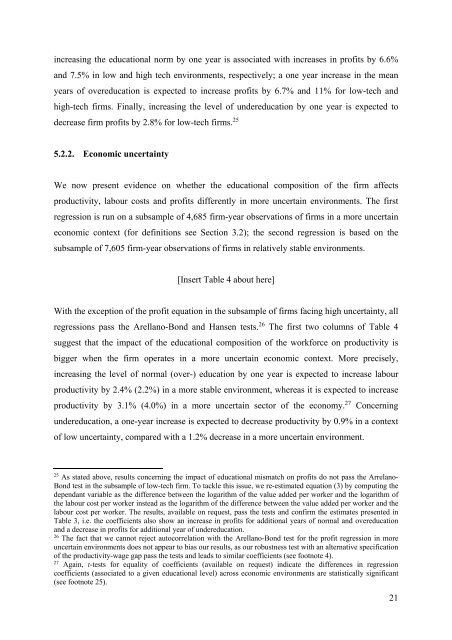CEB Working Paper
240798&r=lma
240798&r=lma
You also want an ePaper? Increase the reach of your titles
YUMPU automatically turns print PDFs into web optimized ePapers that Google loves.
increasing the educational norm by one year is associated with increases in profits by 6.6%<br />
and 7.5% in low and high tech environments, respectively; a one year increase in the mean<br />
years of overeducation is expected to increase profits by 6.7% and 11% for low-tech and<br />
high-tech firms. Finally, increasing the level of undereducation by one year is expected to<br />
decrease firm profits by 2.8% for low-tech firms. 25<br />
5.2.2. Economic uncertainty<br />
We now present evidence on whether the educational composition of the firm affects<br />
productivity, labour costs and profits differently in more uncertain environments. The first<br />
regression is run on a subsample of 4,685 firm-year observations of firms in a more uncertain<br />
economic context (for definitions see Section 3.2); the second regression is based on the<br />
subsample of 7,605 firm-year observations of firms in relatively stable environments.<br />
[Insert Table 4 about here]<br />
With the exception of the profit equation in the subsample of firms facing high uncertainty, all<br />
regressions pass the Arellano-Bond and Hansen tests. 26 The first two columns of Table 4<br />
suggest that the impact of the educational composition of the workforce on productivity is<br />
bigger when the firm operates in a more uncertain economic context. More precisely,<br />
increasing the level of normal (over-) education by one year is expected to increase labour<br />
productivity by 2.4% (2.2%) in a more stable environment, whereas it is expected to increase<br />
productivity by 3.1% (4.0%) in a more uncertain sector of the economy. 27 Concerning<br />
undereducation, a one-year increase is expected to decrease productivity by 0.9% in a context<br />
of low uncertainty, compared with a 1.2% decrease in a more uncertain environment.<br />
25<br />
As stated above, results concerning the impact of educational mismatch on profits do not pass the Arrelano-<br />
Bond test in the subsample of low-tech firm. To tackle this issue, we re-estimated equation (3) by computing the<br />
dependant variable as the difference between the logarithm of the value added per worker and the logarithm of<br />
the labour cost per worker instead as the logarithm of the difference between the value added per worker and the<br />
labour cost per worker. The results, available on request, pass the tests and confirm the estimates presented in<br />
Table 3, i.e. the coefficients also show an increase in profits for additional years of normal and overeducation<br />
and a decrease in profits for additional year of undereducation.<br />
26<br />
The fact that we cannot reject autocorrelation with the Arellano-Bond test for the profit regression in more<br />
uncertain environments does not appear to bias our results, as our robustness test with an alternative specification<br />
of the productivity-wage gap pass the tests and leads to similar coefficients (see footnote 4).<br />
27<br />
Again, t-tests for equality of coefficients (available on request) indicate the differences in regression<br />
coefficients (associated to a given educational level) across economic environments are statistically significant<br />
(see footnote 25).<br />
21


